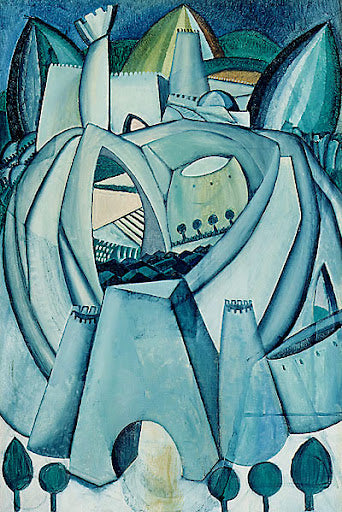Description
The painting "Castillo" (1912) of Amadeo de Souza-Cardoso is a work that incisively reflects the innovative and often radical style of the Portuguese painter, an outstanding exponent of modernism in Portugal. In this piece, Souza-Cardoso display a bold approach towards the representation of the architectural landscape, joining elements of geometry with a vibrant palette that captures the essence of the place that portrays. The work provides a fascinating look at the work of an artist who, although not as recognized as other contemporaries in the field of European art, had a considerable impact on the artistic scene of the twentieth century.
The composition of painting is essential to understand the vision of Souza-Cardoso. The castle, which surely evokes a sense of history and legacy, is located in the center of the work, surrounded by a landscape that seems both real and imagined. The structure has an almost cubic form, reinforcing the idea of solidity and permanence. This castle, with its earthly tones and architectural details, contrasts significantly with the bright and almost abstract colors of its surroundings. These more vibrant nuances, driven by the influence of Fauvism, give the work a unique energy, evoking the spirit of the Portuguese landscape while suggesting contemporary dynamism.
The use of color in "Castillo" is one of the most striking aspects. Souza-cardoso uses a range of shades, from the ocher and gray that suggest the castle of the castle, to the intense and blue green of the surrounding landscape. This mixture not only enriches the work visually, but also establishes a dialogue between the imposing building and nature. The artist seems to invite the viewer to reflect on the interrelation between human constructions and the natural environment, an issue that is both timeless and deeply relevant.
There are no visible characters in "Castillo", which suggests an atmosphere of introspection and loneliness. This absence of human figures can be interpreted as an invitation to contemplation, where the viewer becomes an observer who contemplates the majesty of the place without the distraction of the human being. This stylistic choice resonates with other works by Souza-Cardoso himself, which often explore the landscape and cultural identity without the active presence of characters. His work often emphasizes a sense of belonging through the representation of spaces that, although devoid of humanity, are loaded with history and meaning.
The context of "Castillo" also reveals an essential part of the legacy of Souza-Cardoso. During his years in Paris, the artist soaked from the various artistic movements of the time, including Cubism and Fauvism, merging these styles in his own visual language. "Castillo" is not a simple representation, but rather a compendium of influences that reformulate their particular vision of the landscape and architecture. In this sense, his work anticipates, and perhaps even anticipates, more contemporary currents that explore the relationship between the natural and the constructed.
In conclusion, "Castillo" (1912) of Amadeo de Souza-Cardoso is a splendid manifestation of his talent and his commitment to modernity, encapsulating his ability to merge the abstract with the figurative in a space loaded with symbolism. The work invites viewers to a visual trip where architecture and nature dialogue, reminding us of the importance of our constructions in the context of the surrounding environment. Souza-Cardoso, through this work, reaffirms its place in the history of modern art, providing a new dimension to the appreciation of landscape and architecture in painting.
KUADROS ©, a famous paint on your wall.
Hand-made oil painting reproductions, with the quality of professional artists and the distinctive seal of KUADROS ©.
Art reproduction service with satisfaction guarantee. If you are not completely satisfied with the replica of your painting, we refund your money 100%.

